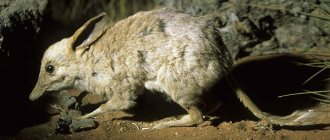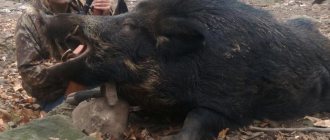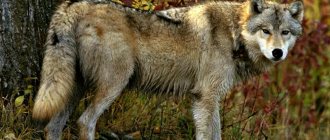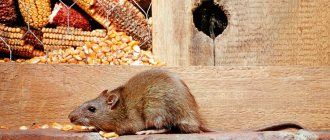Wolves were once among the most common land animals
The original range of wolves consisted of most of the Northern Hemisphere - from the Arctic to 20°S latitude, which runs through south-central Mexico, northern Africa and southern Asia. However, due to habitat destruction, environmental change, human persecution, and other barriers to population growth, wolves are currently found only in a few areas of the United States, Alaska, Canada, Eurasia, and Mexico (small populations). They occupy a wide variety of habitats, from arctic tundra and forests to prairies and arid landscapes. They cannot be found only in deserts and tropical forests.
Hunting and food
Arabian wolves feed on ungulates, hares, various rodents, reptiles, carrion and even insects. They hunt mainly in the dark to avoid the heat. These wolves also eat fruits and some plants. Unfortunately, they can also attack domestic animals up to the size of a sheep, for which they are persecuted by farmers. In Oman, the wolf population has increased significantly after hunting them was banned. There is a good chance that the Arabian wolf population will recover in several areas of the region in the relatively near future. In Israel, between 100 and 150 individuals now live in the Negev and Arava.
Wolves are the largest species of wild canid
Wolves vary in size mainly depending on geographic location, with southern populations typically smaller than northern ones. The overall body size (from tip of nose to tip of tail) is 1 to 1.3 meters in males and 0.87 to 1.17 meters in females. The tail size ranges from 35 to 52 cm in length. The body weight of males varies from 35 to 80 kg, females - from 23 to 55 kg. Height (measured from the base of the paws to the shoulder) ranges from 60 to 90 cm. The distance between the fangs is about 4 cm.
Photo: Philippe Montes
The smallest species, weighing only 14 kg, settled in the Middle East. The largest species, reaching a body weight of 75-80 kg, live in Canada, the Russian Federation and Alaska.
Wolves' fur color varies geographically
It can range from pure white in arctic populations to a mixture of white with shades of grey, brown, light chestnut and black to almost uniform black in some southern populations. The back is usually dark in color, while the face, ears and limbs are lighter in color. The underparts are whitish or pale gray in color, and the tail is darkest above the caudal gland and paler below the tip, which is almost always completely black. Wolves also have a thick undercoat, providing them with excellent insulation in cold conditions.
Wolves were domesticated at least twice
Wolves are recognized as the ancestors of all domestic dog breeds (Canis lupus familiaris), including wild forms such as dingoes (Canis lupus dingo) and New Guinea singing dogs (Canis lupus halstromi). Genetic evidence suggests that wolves were domesticated by humans at least twice, and possibly as many as 5 times. Artificial selection by humans for certain traits, including size, appearance, aggressiveness, loyalty, and many other desirable skills, has resulted in a surprising variety of domestic dog morphologies.
Wolves are pack animals
Photo: Eva Blue
Each flock contains from two to thirty-six individuals, depending on the habitat and abundance of prey. Most flocks consist of 5-9 individuals. Packs usually consist of an alpha pair and their offspring, including cubs from previous years. Unrelated immigrants can also become pack members.
There is a strong dominance hierarchy within each pack. The leader of the pack, usually the alpha male, dominates all other individuals. The next dominant individual is the alpha female, who obeys only the alpha male. In the event that the alpha male is injured or otherwise unable to maintain his dominance, the beta male will take his place in the hierarchy, and alpha males will usually leave the pack. Rank in the pack hierarchy determines which animals mate and which individuals eat first. Rank is demonstrated through postural cues and facial expressions such as crouching, chin touching, and rolling over while showing the belly.
Wolves are monogamous
The dominant pair in a wolf pack are the only members that reproduce. This pair is monogamous, although with the death of the alpha individual, a new alpha male or alpha female appears and takes on the role of the new partner. Lower-ranking males do not mate and often suffer from stress called "psychological castration." Surprisingly, lower females are sometimes so afraid of the alpha female that they don’t even go into heat.
Photo: Yannick Menard
Mating occurs between January and April, with northern populations breeding later than their southern counterparts. Females choose a mate and often form a pair bond for life. Pairs of wolves spend a lot of time together. In females, estrus occurs once a year and lasts from 5 to 14 days, at which time mating occurs. After mating, the female digs a den in which she raises her offspring. The den is often dug with an entrance that goes down first and then rises again to a higher platform. This structure avoids flooding. The cubs are born in the den and remain there for several weeks after birth. Wolves make other dens under cliffs, under fallen trees and in caves.
The gestation period lasts from 60 to 63 days
Litter sizes range from one to fourteen cubs, with the average litter size consisting of 6-7 cubs. Wolf cubs are born blind and deaf. They weigh approximately 0.5 kg and depend on the warmth of their mother. At 10-15 days of age, wolf cubs open their eyes, but at this age they can only control their front legs, so crawling is their only way of moving. After five to ten days, the young can stand, walk and make sounds.
Non-breeding females will help raise the young and "look after them". Until 45 days of age, they are fed regurgitated food by all members of the flock. After reaching this age, wolf cubs begin to be fed meat. They remain in the den until they are 8-10 weeks old. Females stay with their young for almost 3 weeks.
Photo: ML
Between days 20 and 77, wolf cubs leave the den for the first time and learn to defend themselves by fighting with other wolf cubs. Interactions during this time, as well as the dominant status of the mother, ultimately determine their position in the pack hierarchy. Wolf cubs develop quickly, they must be large and developed enough to hunt with the pack when winter comes. At about ten months of age, the young begin hunting with a pack. Most young wolves leave their native pack between the ages of 1 and 3 years.
Reproduction
The only time Arabian wolves become territorial is when they have cubs. Sometimes a litter consists of 12 cubs, but usually there are only 2 or 3. They are born blind, the mother feeds them milk for up to 8 weeks, after which the parents begin to regurgitate semi-digested food for them.
8861
8862
8863
8864
8865
Wolves are carnivores
They hunt prey on their own or in packs, steal prey from other predators, or scavenge for carrion. Prey is discovered by chance or by smell. Animals included in the diet of wolves vary geographically and depend on the availability of prey. Wolves primarily hunt in packs for large prey such as elk, bison, musk ox and reindeer. Once these large ungulates are finally defeated, the wolves sink their fangs into their rump, sides and shoulder blades, tearing off pieces of meat with the help of powerful jaws.
Wolves control prey populations by preying on weak, old, and immature individuals. In one meal, a wolf can eat up to 9 kg of meat. Wolves usually eat the entire carcass, including hair and bones. Smaller prey such as beavers, hares and other small mammals are hunted primarily by lone wolves and make up a significant portion of their diet. Wolves may also eat livestock and food waste when available.
June - September
On abundant nutritious food, wolf cubs quickly grow and become stronger, their appetite increases, and every day it becomes more and more difficult for their parents to feed them. A seasoned wolf and she-wolf begin to hunt for domestic animals: sheep, piglets and geese - and bring them alive to the den. In front of the satisfied parents, watching their offspring with narrowed, slanting eyes, the grown-up wolf cubs viciously and quickly deal with their prey and tear it apart.
Wolves attacked a flock of sheep.
By the beginning of the last century in the United States, people exterminated almost all wolves
Photo: Philipp Pilz
As settlements grew in the southern United States, so did the belief that livestock populations were in danger of extinction due to large wolf populations. As a result, in the middle of the 20th century there were up to several hundred individuals there. Following this, successful wolf restoration plans were developed throughout the country. There are currently approximately 2,600 wild wolves in the southern United States.
Populations in Alaska and Canada remain stable and fairly large. There are currently between 6,000 and 8,000 wolves in the state of Alaska, and the Canadian population is estimated at approximately 50,000. Wolves in Canada are protected by local governments and are not currently endangered.
In western Eurasia, wolf populations have declined to isolated small packs in Poland, Scandinavia, Russia, Portugal, Spain and Italy. Wolves were extirpated from the British Isles in the 1700s and nearly disappeared from Japan and Greenland in the 20th century. Greenland wolf populations now appear to have fully recovered. The status of wolves in much of eastern Eurasia is poorly understood, but populations are likely stable in many areas.
Habitats
Currently, this predator can be found in some European countries: Poland, Spain, Portugal and Italy, as well as in the Scandinavian Peninsula, the Baltic States and the Balkans. It lives in Asian countries such as Korea, China, Mongolia, and Kazakhstan. The Middle East is inhabited by them only in the north. In North America it lives everywhere north of Mexico. This predator does not live in South America.
In Russia, the animal can be found everywhere, with the exception of some islands.
Each species has its own habitat preferences. Wild wolves live in the tundra, semi-desert, steppe, forest-steppe, from the foot of the mountains to the heights of alpine meadows. Not afraid to settle near human habitation.
Having found out where wolves live, we will move on to studying their lifestyle and habits.
Did you know?
- Among true wolves, there are two species: Canis lupus (often known simply as "gray wolves") and Canis rufus (red wolf). The second species is smaller in size, has elongated legs and shorter fur.
- The territory of a wolf pack ranges from 130 to 13,000 square kilometers. Wolves are very territorial animals, so wolves from other packs and coyotes will attack lone or young wolves that dare to invade their territory.
- Vocalizations allow pack members to communicate information to each other about where they are, when they should gather for group hunting, and where the boundaries of their territories are. Communication through scent is usually carried out only by the alpha male and is used to communicate with other packs.
- Females reach maturity at two years of age, while males do not reach full maturity until three years of age.
- Wolves can live 13 years in the wild, although their average lifespan is 5-6 years. Adults usually die of old age or from injuries received while hunting or fighting other wolves. In captivity they can live up to 15 years.
- Wolves have about 200 million olfactory cells. For comparison, people have no more than 5 million. Wolves can sense the presence of other animals over 1 mile away.
- A wolf's eyes are blue at birth. Their eyes turn yellow by eight months of age.
Features of behavior
Different animals have different attitudes towards their offspring. On the Commander Islands, arctic fox families, while the puppies are small, sometimes unite, even merging into three families. The female feeds milk to all the young. In addition to the unification of families, theft of puppies from each other is also observed. Those who are kidnapped are fed the same as their puppies. Animals care for their offspring in different ways. Much still needs to be explored and explained. Wildebeest often kill sick and weakened individuals in their herds. Marmots leave the hole if one of the family members dies in it. This saves them from contracting the plague. Gerbils that are at risk of this disease sometimes bury the corpses of their relatives.
The wolf has well-developed senses and is very alert and careful. The wolf is very beautiful in its own way. His movements are surprisingly soft and calculated. This animal can move completely silently even in the thickest thickets. The wolf, thanks to constant training, has a well-developed muscular system. With a powerful skeleton and excellent angles of articulation of the limbs, a seasoned wolf at full swing reaches a speed of 65 km/h: he can take on a hare or a fox in a chase. AA Cherkasov writes: “The wolf is very strong in comparison with its size; it is not uncommon that, with its teeth, it drags a whole ram on its back, not allowing it to reach the ground, and moreover, with such speed that a person is not able to catch up with it.” The wolf is extremely tough to wound.











